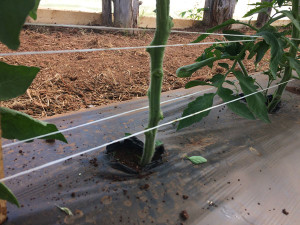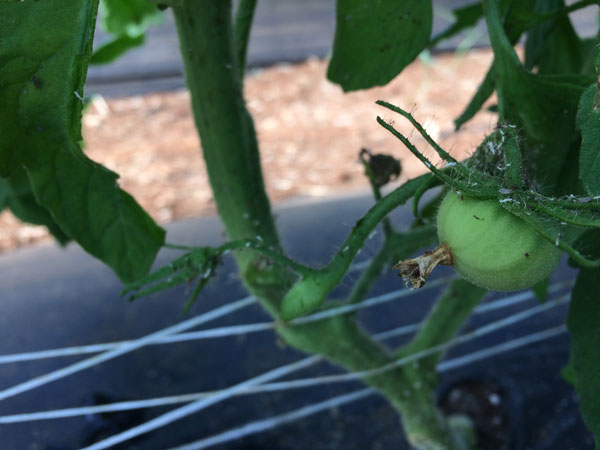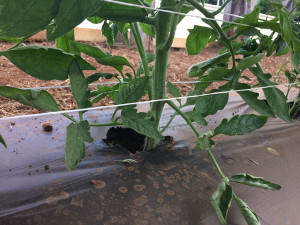by Gena Moore, CFSA’s Organic Research Coordinator
Tomato field production comes with many challenges. Tomato plants are susceptible to many seasonal diseases and conditions that impact plant health and reduce marketable yields. Although many challenges exist, there are some strategies you can take to mitigate disease risk and improve yield. Strategies include both pre-plant and post-plant steps, so if you already have plants in the ground, consider implementing post-plant strategies this year and plan to incorporate pre-plant strategies later this year and in the next growing season. Soil borne diseases have different impacts and control methods are different then what we’ll cover here.
For more information on soil borne disease for tomatoes: http://www4.ncsu.edu/~clrivard/2007_Soilborne_Diseases.pdf
Pre-Plant Strategies
Variety selection is the key to reducing disease risk. If a large marketable harvest is your goal, consider picking disease resistant and early producing varieties. Some great choices that will work well across the Carolinas are: Big Beef, Celebrity, Early Girl, Defiant and Iron Lady. Many Roma and cherry tomatoes perform well throughout the growing season as well. Along with variety selection, grafting is also an option for farmers to help prevent disease. You can graft yourself or purchase grafted plants. For more information: https://www.carolinafarmstewards.org/expert-tip-grafting-heirloom-tomatoes/
Spacing and trellising impacts disease spread and ventilation around plants. Choosing to plant one row of tomatoes per bed, at 18”-24” in-row spacing allows for good ventilation on a variety of trellising structures. Three of the most effective trellising structures for field production of tomatoes are: Florida weave, fencing/panels, and line trellising. Picking the correct trellising system for your production depends on bed type, variety and production goals. For example: growing Big Beef tomatoes on a line trellising system can lengthen the production season and the plants conform well to single leader pruning. In contrast, using Florida weave with a determinate type tomato, like Oregon Spring, works very well to hold in more lateral growth typical of the variety.

Florida weave trellising being used to keep tomato plants upright, increasing ventilation and reducing plant contact with soil surface. Photo by Gena Moore.
Post-Plant Strategies
Regardless of your pre-plant decisions, there are some post-plant strategies that can decrease disease risk. Pruning plants and cultural control methods provide countless benefits, many impacting disease control. Starting at the bottom of the plant, prune off the lower leaves that come in contact with the ground or mulch. As the plant grows and accumulates upper foliage, prune lower leaves up to the first flower cluster. This removes lower leaves that may be going through senescence, reduces plant contact with the soil surface and reduces potential entry points for disease to enter the plant. Prune as close to the plant stem as possible to further reduce entry points for disease. Remember to REMOVE infected plants as soon as detected. Removal of diseased plants is the most important step in reducing disease spread.

Caption: Left shows a German Johnson tomato plant with lower leaves and suckers. Right you see the same plant after being pruned. Note there are no suckers remaining and no foliage touching the black plastic. Photos by Gena Moore.
Scout for insects frequently. Insects not only cause chewing damage to plants and fruit but can also spread disease. Noting insects and keeping populations under control can reduce disease risk. A few insects to look out for are: leaf hoppers, white flies and thrips. Check leaf surfaces, underneath foliage and in flowers. Monitor populations and take cultural and/or biological control when needed.

Removing foliage can uncover insect infestations. Here you see an aphid infestation. Photo by Gena Moore.
Irrigation can impact disease as well. Consider irrigating in the morning to decrease the length of time the plant foliage is wet (leaf wetness). In contrast, if you water in the afternoon or evening, the leaves have the potential to stay wet during watering and throughout the night, prolonging the leaf wetness. By watering in the morning, all moisture on the foliage will evaporate leaving the plants dry for the rest of the day and into the night. If using drip irrigation the impact on leaf wetness is minimal, although AM and early PM watering is still recommended for efficient water use by the plants.
Another preventative measure for reducing or controlling tomato disease is the application of disease-control substances. Several organic, conventional and homemade substances can be applied as a preventive measure. Once a disease is detected, many substances can help control the outbreak. Eliminating an established disease is difficult, especially under organic and/or sustainable production practices. Many tomato diseases are either bacterial or fungal and can be treated with a broad spectrum application of Serenade or similar substance. Early and late blight, both very common issues, can be prevented/treated with a copper fungicide. Remember to clear all substances with your certifying agency, if applicable, and read the FULL label before using. Check out https://www.planetnatural.com/garden-advice/ for more information on disease and organic application options.
Harvesting to Improve Fruit Quality
Shelf life and quality of tomatoes can be impacted not only by disease but also by harvesting techniques. Tomatoes ripen from the inside out. This means that when you see full color on the outside, the fruit is ripe all the way through and, therefore, more vulnerable to bruising and damage. Fortunately, tomatoes ripen off the vine. Picking the fruit at an early to mid-breaker stage can decrease the potential for damage during the post-handling process. This is particularly true for heirloom varieties, which tend to ripen fast and bruise easily. Consider harvesting tomatoes at an early breaker stage a few days before the market, cleaning (if needed) and packing in boxes. Simply unpack ripened tomatoes for sale at the market. Consider selling green tomatoes as well. Many buyers enjoy making fried green tomatoes and will pay similar amounts for green tomatoes compared to ripe.
Leave the cap. When harvesting tomatoes, snap the apex of the branch right above the fruit. This leaves the cap in place at the top of the fruit. You can harvest many varieties this way without using pruners, reducing the potential spread of disease. To pack tomatoes with attached caps simply place the first layer in the box upside down and the second layer of tomatoes right-side up. Avoid using any more than two layers for capped tomatoes. These caps give the tomato a great visual appeal at the market, although it does little to improve the shelve life.
Helpful Links
For more information on common tomato plant diseases in the Carolinas: https://vegetables.ces.ncsu.edu/tomatoes-diseases/
For more information on how to submit a plant sample for disease diagnosis: https://projects.ncsu.edu/cals/plantpath/extension/clinic/extension.html




